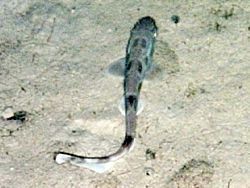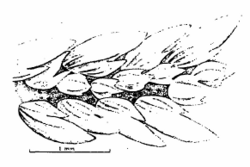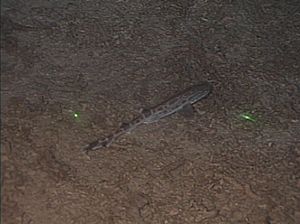Roughtail catshark facts for kids
Quick facts for kids Roughtail catshark |
|
|---|---|
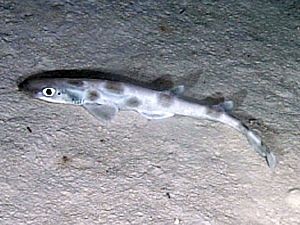 |
|
| Conservation status | |
| Scientific classification | |
| Genus: |
Galeus
|
| Species: |
arae
|
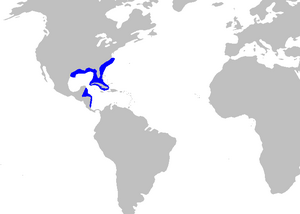 |
|
| Range of the roughtail catshark | |
| Synonyms | |
|
Pristiurus arae Nichols, 1927 |
|
The roughtail catshark (Galeus arae) is a small shark that lives deep in the ocean. It's also known as the marbled catshark because of its cool patterns. This shark is part of the catshark family, called Scyliorhinidae.
You can find the roughtail catshark in the northwestern Atlantic Ocean, the Gulf of Mexico, and the Caribbean Sea. It lives in waters from North Carolina all the way down to Costa Rica. These sharks usually hang out at depths between 36 and 702 meters (about 118 to 2,300 feet).
This shark is quite small, growing to about 33 centimeters (13 inches) long. It has a slim body with dark, marbled patterns like saddles and spots. A special feature is a ridge of large, tooth-like scales along the top edge of its tail fin. The roughtail catshark mostly eats shrimp. It lays eggs, which means it's an oviparous species. Even though it sometimes gets caught by accident in fishing nets, it's not considered endangered.
Contents
Meet the Roughtail Catshark: What It Looks Like
The roughtail catshark is one of the smallest sharks in its group. It grows to be no longer than 33 centimeters (about 13 inches). It has a slim body that feels firm to the touch. Its head is a bit flat, and its snout is long and pointy.
Its eyes are shaped like horizontal ovals. They have a simple third eyelid for protection. Behind each eye, there's a tiny hole called a spiracle. The shark's mouth is wide and curved, with small grooves at the corners. It has many small teeth, about 59 to 65 rows in the upper jaw and 58 to 60 rows in the lower jaw. Each tooth has a sharp point in the middle and one to three smaller points on each side. Like most sharks, it has five pairs of gill slits for breathing.
The roughtail catshark has two dorsal fins (on its back). The first one is above its pelvic fins, and the second one is similar in size and shape, located above its anal fin. Its pectoral fins (on its sides) are large and rounded. The tail fin is low, with a small lower part. A cool feature is a saw-toothed ridge of enlarged scales along the top edge of its tail fin.
This shark is yellowish-brown on top. It has a marbled pattern with dark saddle-like markings and spots along its back and tail. Some smaller sharks have markings that look like lines. Larger sharks might have round blotches on their sides. These patterns can be faint or very clear, sometimes outlined in white. Its belly is pale, and the inside of its mouth is black.
Where Roughtail Catsharks Live
The roughtail catshark lives in specific areas that don't overlap with other similar shark species. One group lives from North Carolina south to the Caribbean and the Yucatán Peninsula. This group also extends west to the Mississippi River Delta. Another group is found in the Caribbean Sea near the coasts of Honduras, Nicaragua, and Costa Rica.
This shark is a bottom-dwelling species. It usually lives on the slopes of continents and islands, sometimes moving onto the shallower continental shelf. It can be found in large numbers in some places, while other areas have none. Sharks in the northern areas have been found at depths from 36 to 732 meters (about 118 to 2,400 feet). Those in the southern areas live deeper, from 338 to 631 meters (about 1,100 to 2,070 feet).
It seems that water temperature is more important than depth for where these sharks live. They have been caught in water ranging from 5.6 to 11.1 degrees Celsius (about 42 to 52 degrees Fahrenheit). Both young and adult sharks can be found up to 450 meters (about 1,476 feet) deep. However, usually only adult sharks are found in deeper waters.
Life Cycle and What They Eat
The roughtail catshark mainly eats shrimp. Sometimes, many of these sharks gather together in large schools.
This species is oviparous, which means it lays eggs. Female roughtail catsharks have one working ovary and two working tubes that carry eggs. Only one egg matures in each tube at a time. The eggs are protected inside tough, flask-shaped capsules. These capsules are about 4.9 to 5.1 centimeters (about 1.9 to 2 inches) long. The top of the capsule is about 1.2 to 1.4 centimeters (about 0.5 inches) wide, and the bottom is about 1.6 centimeters (about 0.6 inches) wide. The top corners of the capsule have coiled tendrils. These tendrils help the egg case attach to things on the seafloor. The places where these sharks lay their eggs might be in very rough areas underwater. Both male and female roughtail catsharks become ready to reproduce when they are about 27 to 33 centimeters (about 10.6 to 13 inches) long.
Roughtail Catsharks and Humans
The roughtail catshark is harmless to humans and doesn't have any commercial value. It's too small to be caught by most fishing gear. However, it is sometimes caught by accident as bycatch in shrimp trawl nets.
In 1966, shark expert Stewart Springer noted that these sharks were often caught in shrimp trawls along the coast of Florida. We don't know the full impact of fishing on this species in U.S. waters. However, because of where it lives and lays its eggs, it might be somewhat protected from fishing. Also, shrimp trawling in Central America doesn't usually go into the deep waters where these sharks live. Because of this, the International Union for the Conservation of Nature (IUCN) has listed the roughtail catshark as a species of Least Concern. This means it's not currently at risk of disappearing.
See also
 In Spanish: Galeus arae para niños
In Spanish: Galeus arae para niños



